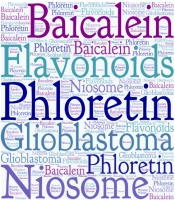Cancer is a disorder in which certain cells in the body grow out of control and spread to other parts of the body as the disease progresses. According to the National Cancer Institute (NCI), in 2022, there were 1,918,040 new cancer cases and 609,360 cancer deaths in the United States (1). Among the types of cancers, glioblastoma (GBM) multiforme is the most aggressive and destructive brain tumor that cannot be cured despite modern treatment methods, including radiotherapy and chemotherapy. The average life expectancy of these patients is about 14.6 months, and less than 5% of the patients can survive more than five years. A concerted effort is urgently needed to identify and characterize more effective therapies to alleviate this devastating loss of human life (2, 3).
Flavonoids, as polyphenolic compounds, found in fruits, vegetables, flowers, chocolate, tea, wine, and other plant sources are the most common polyphenols found in nature (4). Flavonoids are a diverse family of compounds with over 9000 members, including flavones, flavanols, isoflavones, flavonols, flavanones, and flavanonols. The safety profile of flavonoids has been described as excellent (no toxicity at 140 g/day) with no known significant side effects (5). Flavonoids have a wide range of pharmacological effects, including antioxidant, anti-inflammatory, cardioprotective, hepatoprotective, antimicrobial, and cancer properties (6).
The ability of flavonoids to scavenge free radicals, regulate cellular metabolism, and prevent oxidative stress-related diseases have been demonstrated by numerous studies (7). Among different types of flavonoids, baicalein and phloretin as polyphenol compounds have strong antioxidant and anti-inflammatory properties (8). They also show promising therapeutic effects on glioblastoma.
Baicalein and phloretin, however, need to cross the blood-brain barrier to exert their effects. It has been revealed that lipophilicity, solubility, and topological polar surface area, among other physicochemical factors, face significant challenges despite having extremely important therapeutic effects. Therefore, adopting new drug delivery methods to transfer therapeutic agents is needed more than ever.
The application of nanotechnology may facilitate formulating of chemotherapeutic drugs and the development of new therapies that can overcome their solubility, stability, and side effect problems present in their conventional forms. The application of nanotechnology in drug delivery has many advantages, such as improving pharmacokinetic properties, reducing toxicity, and increasing the half-life of the drugs. Therefore, using nanocarriers provides researchers and practitioners with a great opportunity to overcome the problems in drug delivery. Pharmaceutical nanocarriers are classified into different categories, including metal, polymer, hydrogel, and ceramic nanoparticles, as well as lipid-based carriers, such as liposomes and niosomes.
Nano-sized drug carriers have a higher surface-to-volume ratio, which improves pharmacokinetic properties, reduces toxicity through the concentration of drug at the targeted site, facilitates intracellular uptake, and increases drug stability. One of the promising nanocarriers is niosomes, a bilayer structure made by self-association of nonionic surfactants and cholesterol in aqueous phases. As a biodegradable and biocompatible nanocarrier, niosomes have high stability and enable sustained and controlled drug delivery at target sites (9, 10). Generally, niosomal structures are influenced by a variety of factors, including preparation methods, surfactant types, quantities, lipid hydration temperatures, and reaction durations. By altering and optimizing these factors, the performance of niosomes could be enhanced for drug delivery. The sizes of niosomes range from 10 to 1000 nm. The amphiphilic nature of these nanocarriers makes them compatible with both hydrophilic and hydrophobic drugs. Hydrophilic drugs can be entrapped inside the core cavity while hydrophobic drugs can be trapped outside it, in the non-polar region (11). They prevent the elimination of poorly-absorbed drugs from circulation and protect them against the biological environments, in addition to improving their oral bioavailability. As a result, these niosomal nanocarriers encapsulated with baicalein and phloretin can be used as therapeutic agents for treating glioblastoma.
